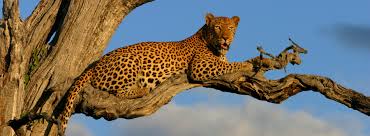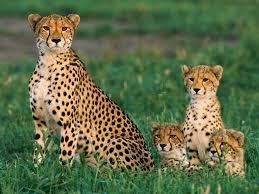The major big cats that everyone knows that live in Africa are lions, leopards, and cheetahs.
 Leopards are a lot smaller than lions and can get up to about one hundred and forty pounds and can live up to twenty one years in captivity. Their coats are generally lighter but can have a range of shades yellow and tawny brown, they have circular spots and sometimes square spots in different patterns and designs that are rosette or black in color. They like to live in places where they're hidden easily, such as, rocky woodlands and riverine forests where they have access to trees and hiding crevices. Leopards are more nocturnal, this plus their surroundings and coat camouflage makes it very hard to spot. When Leopards hunt, they slink under and around objects skillfully to reach their prey. They do not chase their prey, so they have to be at a close range when they attack. When they do not wish to hunt, leopards can just lift their tail and flip the tip of the tail to show they're not interested in hunting. Leopards are solitary animals and often avoid one another except for mating or if they have cubs. Males typically have larger range territory and females have less, which sometimes overlaps into another males territory. They have a good sense of smell and have many means of marking their territory when needed. They also communicate through many different ways of hissing, roaring, coughing, and spitting. Leopards like to move constantly, they'll only stay in one area no more than two to three days at a time. They like to lounge in trees and this is usually a good hiding place or a good exit from escaping lions or hyenas. Once they hunt their prey, they'll normally take the carcass to a tree and store it on a limb to eat and keep away from hungry eyes. They're stealthy and cunning hunters who use strategy to kill. They learn from a young age to kill small animals, but then grow to eat fish to birds to mammals and rodents. Leopard litters typically consist of around two to three cubs, but normally only one to two survive to adult-hood. Their coats are a smoky grey in color and change as they hit adolescents. When the cubs are first born the mother, needing to provide for herself and watch the territory, hides the cubs in brush to rock crevices, but moves them every few days, so no predators notice and attack. One of the only predators of the leopard is man, their coats are prized for fur coats and just for fun. Lions can and will kill a leopard if they feel threatened and hyenas will kill leopard cubs if they can find them.
Leopards are a lot smaller than lions and can get up to about one hundred and forty pounds and can live up to twenty one years in captivity. Their coats are generally lighter but can have a range of shades yellow and tawny brown, they have circular spots and sometimes square spots in different patterns and designs that are rosette or black in color. They like to live in places where they're hidden easily, such as, rocky woodlands and riverine forests where they have access to trees and hiding crevices. Leopards are more nocturnal, this plus their surroundings and coat camouflage makes it very hard to spot. When Leopards hunt, they slink under and around objects skillfully to reach their prey. They do not chase their prey, so they have to be at a close range when they attack. When they do not wish to hunt, leopards can just lift their tail and flip the tip of the tail to show they're not interested in hunting. Leopards are solitary animals and often avoid one another except for mating or if they have cubs. Males typically have larger range territory and females have less, which sometimes overlaps into another males territory. They have a good sense of smell and have many means of marking their territory when needed. They also communicate through many different ways of hissing, roaring, coughing, and spitting. Leopards like to move constantly, they'll only stay in one area no more than two to three days at a time. They like to lounge in trees and this is usually a good hiding place or a good exit from escaping lions or hyenas. Once they hunt their prey, they'll normally take the carcass to a tree and store it on a limb to eat and keep away from hungry eyes. They're stealthy and cunning hunters who use strategy to kill. They learn from a young age to kill small animals, but then grow to eat fish to birds to mammals and rodents. Leopard litters typically consist of around two to three cubs, but normally only one to two survive to adult-hood. Their coats are a smoky grey in color and change as they hit adolescents. When the cubs are first born the mother, needing to provide for herself and watch the territory, hides the cubs in brush to rock crevices, but moves them every few days, so no predators notice and attack. One of the only predators of the leopard is man, their coats are prized for fur coats and just for fun. Lions can and will kill a leopard if they feel threatened and hyenas will kill leopard cubs if they can find them. The last savannah big cat is the cheetah. The cheetah can weigh up to one hundred and forty pounds and live to around twenty years. They were built for speed, they're the fastest land animal on Earth. Ranging speeds of around sixty to seventy miles per hour they're not so easy to catch. The have massive lungs, but a skinny rest of the body that keeps it slick and smooth with plenty of oxygen to last a good run. They have black 'tears' that run from their eyes that keep the sun from blinding them. They have long claws that can't be retracted like a normal cat, this is so when the animal is running it can keep good padding on the ground so it can't slip as easily. They also have a long flexible tail that helps for making very sudden turns during the run, the tail makes different movements to keep the cheetah balanced. The cheetah can't run at top speed for a long space of time and when it gets tired after a run, normally they need lots of time to catch their breath. Cheetah's like to live in the open savannah with a few shady trees so they can cool off. Their coats are specially designed for this, they have light colored fur with many spots that are all in different patterns. Cheetahs don't roar like a normal cat, they purr, hiss, or chirp. They also like to hunt during the day, which is also unusual for a big cat. Cheetahs spend most of it's young life learning to hunt and survive from it's mother so they're able to become independent quickly. Even though the cheetah is very fast it still waits until they're very close to the target before striking. They also eat as quickly as possible once they have food because anything can come and take it from them. Cheetahs don't like a fight and normally run when a bigger or tougher predator comes towards them. They have litters of about four to six cubs, which have a smokey tuft of hair running along their back and neck until they get older, showing that they're still young. The cubs stay with their mother for a long time, around three years, in which they learn all the necessities of life to survive. Once old enough the mother will abandon her young and hope that they'll apply the tools they've learned to survive on their own.
The last savannah big cat is the cheetah. The cheetah can weigh up to one hundred and forty pounds and live to around twenty years. They were built for speed, they're the fastest land animal on Earth. Ranging speeds of around sixty to seventy miles per hour they're not so easy to catch. The have massive lungs, but a skinny rest of the body that keeps it slick and smooth with plenty of oxygen to last a good run. They have black 'tears' that run from their eyes that keep the sun from blinding them. They have long claws that can't be retracted like a normal cat, this is so when the animal is running it can keep good padding on the ground so it can't slip as easily. They also have a long flexible tail that helps for making very sudden turns during the run, the tail makes different movements to keep the cheetah balanced. The cheetah can't run at top speed for a long space of time and when it gets tired after a run, normally they need lots of time to catch their breath. Cheetah's like to live in the open savannah with a few shady trees so they can cool off. Their coats are specially designed for this, they have light colored fur with many spots that are all in different patterns. Cheetahs don't roar like a normal cat, they purr, hiss, or chirp. They also like to hunt during the day, which is also unusual for a big cat. Cheetahs spend most of it's young life learning to hunt and survive from it's mother so they're able to become independent quickly. Even though the cheetah is very fast it still waits until they're very close to the target before striking. They also eat as quickly as possible once they have food because anything can come and take it from them. Cheetahs don't like a fight and normally run when a bigger or tougher predator comes towards them. They have litters of about four to six cubs, which have a smokey tuft of hair running along their back and neck until they get older, showing that they're still young. The cubs stay with their mother for a long time, around three years, in which they learn all the necessities of life to survive. Once old enough the mother will abandon her young and hope that they'll apply the tools they've learned to survive on their own.